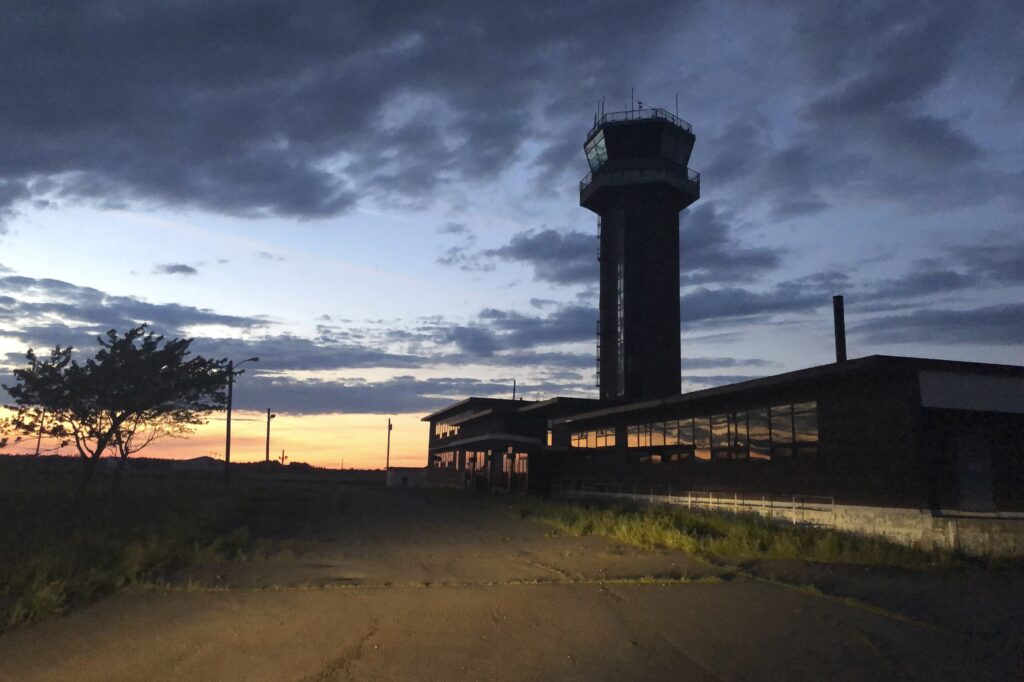
LIMESTONE, Maine — Thirty years after losing Loring Air Force Base, Aroostook County is just starting to see more sustainable economic trends.
But decades of population decline that accelerated after Loring closed on Sept. 30, 1994, remains the most challenging hurdle on the way to securing a prosperous future.
Loring was The County’s largest employer and the biggest driver of economic prosperity. Its closure in 1994 eliminated 4,500 military jobs, 1,100 civilian jobs and 2,181 jobs indirectly supported by the base, such as general contractors, leading to a mass population exodus for Limestone and surrounding communities.
Civilian workers who left brought with them the $129.6 million in personal income that they used to spend in towns like Limestone, Caribou and Presque Isle. As thousands of people left in the ensuing decades, so did much of the hope for economic recovery in the post-Loring years.
In recent years, though, local employers have gotten more innovative, producing specialty agricultural and forestry products that are shipped nationwide. Others are more aggressively attracting tourists through recreational opportunities. All that work has created a county less dependent on the former base, now Loring Commerce Center, for its overall success.
“When you’re so tied to one thing, like an Air Force Base, it’s only a matter of time. If we stayed dependent on Loring, we would’ve always been at risk,” said Scott Dionne, president and CEO of the nonprofit Aroostook Partnership.
Dionne, a Caribou native, is the latest leader of Aroostook Partnership, which formed in 2003 to counter youth out-migration and help local industries to expand their workforce and production.
So far, a more intense focus on forestry, agriculture and tourism has made those industries stronger cornerstones of Aroostook’s economy.
From 2012 to 2017, 400 jobs were added within forestry, largely due to expansions at companies like Irving Woodlands and Louisiana-Pacific. In that same period, the agriculture sector saw investments of more than $30 million, including the $20 million expansion of Pineland Farms in Mars Hill, creating 75 new jobs, according to Aroostook Partnership’s 2017 Caring for the Crown Report.
Though post-2017 data is not yet available, there already are signs of growth within those industries, Dionne said. More companies have expanded their ability to produce “specialty, value-added products” that reach consumers beyond northern Maine.
That includes Penobscot-McCrum in Washburn, which sources local potatoes to make french fries shipped to restaurants; Louisiana-Pacific, which is looking to add a new line of finish products to its New Limerick siding mill; and MaineFlame Inc., which purchased a former lumber mill in Ashland to manufacture steam-exploded wood pellets.
More investments like those can further bolster Aroostook’s gross domestic product, which grew to the sixth-highest of Maine’s 16 counties in 2022 at $6 billion.
“Our economy right now is sustainable and it’s growing,” Dionne said. “We need to double down and focus on our strengths and advantages.”
Tourism has also become a centerpoint of the region’s economy.

From December 2022 to November 2023, The County saw a 17.5 percent jump in tourism with 332,400 people visiting the area. Fifty percent of tourists said that they visited because of outdoor activities like snowmobiling, ATV riding, boating, hiking, fishing and hunting.
Those tourists generated $169.5 million in revenue from shopping, dining at restaurants, entertainment, groceries and paying for transportation, compared with $160.7 million from December 2021 to November 2022. Out of that, more than $80 million from tourism supported wages for people working in those job sectors, according to Aroostook County Tourism.
Loring’s most historic former Air Base sites, including the arch hangar and nuclear weapons storage area, have become crucial to boosting tourism. Thousands of tourists visit those sites every year, and the Loring Air Museum’s open houses are bringing back former military service members and their families.
But in the past 30 years, turning Loring into an active industrial and commercial business center has proven much harder.
In 1993, the Maine Legislature created the Loring Development Authority as a public municipal corporation to redevelop 3,800 acres of the 9,000-acre base.

The authority hired Brian Hamel as its first president and CEO in 1994. Hamel had been director of finance and marketing for the redevelopment of Pease Air Force Base in Portsmouth, New Hampshire, which closed in 1988.
As a newcomer to Aroostook, Hamel knew that marketing Loring to national companies would be harder than in southern New Hampshire. For one thing, Loring is more than 60 miles from the entrance to Interstate 95 in Houlton, making it even farther from major metropolitan cities and regional markets.
“Pease was only 60 miles from Boston, but Loring is in a much more isolated location,” Hamel said. “There was always this perception that rural parts of the country don’t have the population, workforce, transportation and infrastructure to attract private industry.”
That’s why Hamel and Loring’s board of directors wanted to be innovative from the start.
The federal government typically turns over closed military bases to the states they were operating in, but Hamel feared that Maine would not be able to financially take on the burden of redeveloping Loring. When Loring closed, the state lost $75 million in annual payroll, most of which had been taxable.
So Hamel and his board spent three years negotiating with the federal government, and they agreed to give the authority $30 million for maintaining roads and infrastructure and marketing the new commerce center, broken up into $3 million per year for 10 years.
By the time Hamel left his post in April 2005, the authority had largely succeeded. Twenty employers had located there and created 1,500 total jobs, replacing and surpassing the 1,100 civilian jobs lost when the Air Force left.
Major early employers included Defense Finance and Accounting Service, an entity of the Department of Defense; Loring Job Corp, a technical school run by the Department of Labor; Maine Military Authority, a state-run military equipment repair shop; Sitel, a call center; Telford Aviation, specializing in aircraft maintenance and repair; Championship Sports Flooring; MacDonald Enterprises, a finished wood product manufacturer; and a data security company. There were also local car repair shops and restaurants.
The authority opted to lease rather than sell land because they were in good financial shape due to the large federal funds, Hamel said.
But today, Defense Finance and Accounting Service and Loring Job Corp are the only legacy employers left, making up 630 of the now 750 jobs at the commerce center.
In the early 2000s, the federal government’s $3 million per year payments stopped, leaving the authority more reliant on the state’s Job Increment Financing funds, which ties state aid to the total number of jobs.
When businesses left, they took jobs with them, further depleting the authority’s state funds and lease revenue, and their ability to maintain and market Loring. In 2022, the authority hired a marketing consultant with supplemental state budget funds.
Only now does the tide appear to be turning. Last year, the authority made history and sold 450 acres to an outside entity, the Portland-base Green 4 Maine, which has said it will bring in an artificial intelligence research center and a company looking to test launch a low-orbit “spaceplane.” Local businesses have started coming back.
The authority is also gaining ground with its own property.
This year, local developers announced plans to build a more than $55 million potato chip processing plant. A start-up company from Washington, D.C., says it will construct a $4 billion facility to produce sustainable aviation fuel. If successful, those companies would bring 650 and 75 jobs, respectively.
Future developments will likely need to contend with the presence of PFAS chemicals that have been found near Loring’s runway, which researchers believe have been spreading to nearby waterways. The Air Force is expecting a more conclusive study to be published in 2026.
Loring still has potential to help boost Aroostook’s economic growth, Dionne said, but bringing youth to the area remains as challenging as ever.
Despite a slight pandemic bump, the region’s population is still declining. As of July 2023, there were 67,351 people residing in Aroostook, down from 82,000 in 1990.
Many young people still think that a region like The County has no skilled jobs for them, but being more aggressive in growing economic sectors, as well as housing, child care options and educational opportunities should be the focus, Dionne said.
High schools are doing better at offering workforce learning experiences for students, but even elementary school children should be educated on what local jobs are in Aroostook, Dionne said. It might one day encourage them to stay.
Tourism might even help bring in more residents from away who are seeking Aroostook’s quality of life, Dionne said.
Aroostook County Tourism recently launched more targeted digital marketing that highlights unique regional foods and activities based on the seasons. But to help tourists think about moving north, Aroostook Partnership will soon be sending visitors targeted digital ads based on where they’ve gone and what activities they’ve done.
“Population growth really is number one. If you don’t have the people or the growth in population, it’s very difficult to grow industries,” Dionne said.







